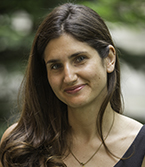
Earlier today, the Honourable Kirsty Duncan, Minister of Science and Sport, on behalf of the Honourable Ginette Petitpas Taylor, Minister of Health, announced 166 new Vanier Canada Graduate Scholarships and 70 new Banting Postdoctoral Fellowships, for a total investment of close to $35 million. These awards are Canada’s most prestigious awards for doctoral students and postdoctoral fellows.
Sixteen McGill graduate students earned Vanier Scholarships, worth $50,000 each year for three years of study and research. The two McGill Banting Fellows each receive $70,000 a year for up to two years of research.
“The Vanier and Banting awards help Canada attract and retain some of the brightest doctoral students and postdoctoral fellows to build up our world-class research talent,” said Duncan. “Since taking office, our government has been working hard to return science and research to their rightful place and today’s investments are helping us do just that.”
Launched in 2008, the Vanier Scholarship program recognizes students who demonstrate excellent leadership skills and a high standard of scholarly achievement in the social sciences and humanities, natural sciences and engineering, or health-related fields.
Meet McGill’s 2019 Vanier Scholars:
Devin Abrahami, Department of Epidemiology, Biostatistics and Occupational Health
Sodium-glucose co-transporter 2 inhibitors and bladder cancer – a causal association or detection bias? An international multicenter cohort study
 Type 2 diabetes is one of the fastest growing diseases in Canada, with approximately 60,000 incident cases per year. The availability of new drug classes, such as sodium-glucose co-transporter 2 (SGLT2) inhibitors, has significantly changed the treatment landscape. These drugs have become increasingly popular, as they effectively lower blood glucose without the side effects of other antihyperglycemic drugs. However, SGLT2 inhibitors have been associated with genital tract infections, and signals from clinical trials indicate a potential association with bladder cancer. To date, however, no study has been conducted in the real-world setting to assess this association. To address this knowledge gap, I will conduct a multicenter cohort study among patients with type 2 diabetes using data sources from Canada, the United States and the United Kingdom. This study will provide much needed safety information on this novel drug class, and will be of value to regulatory agencies, physicians and patients. (Photo courtesy of: Edmond Chung)
Type 2 diabetes is one of the fastest growing diseases in Canada, with approximately 60,000 incident cases per year. The availability of new drug classes, such as sodium-glucose co-transporter 2 (SGLT2) inhibitors, has significantly changed the treatment landscape. These drugs have become increasingly popular, as they effectively lower blood glucose without the side effects of other antihyperglycemic drugs. However, SGLT2 inhibitors have been associated with genital tract infections, and signals from clinical trials indicate a potential association with bladder cancer. To date, however, no study has been conducted in the real-world setting to assess this association. To address this knowledge gap, I will conduct a multicenter cohort study among patients with type 2 diabetes using data sources from Canada, the United States and the United Kingdom. This study will provide much needed safety information on this novel drug class, and will be of value to regulatory agencies, physicians and patients. (Photo courtesy of: Edmond Chung)
Douglas Beaton, Music Technology / Mechanical Engineering
Application of Coupled Acoustic-Structural Finite Element Analysis for Musical Instrument Design, Auralization and Synthesis
 My research combines methods from structural engineering and computational acoustics to aid in the design of acoustic musical instruments. Despite the power of modern day computers, answering a question like: “what would this guitar sound like if we made it out of birch?” still requires building a new guitar. Such reliance on physical prototypes can be costly and time consuming. As a result, innovation in musical instrument design lags in comparison to other industries.
My research combines methods from structural engineering and computational acoustics to aid in the design of acoustic musical instruments. Despite the power of modern day computers, answering a question like: “what would this guitar sound like if we made it out of birch?” still requires building a new guitar. Such reliance on physical prototypes can be costly and time consuming. As a result, innovation in musical instrument design lags in comparison to other industries.
This project will combine simulation techniques from structural engineering and acoustics to predict the sound of a musical instrument based on its construction. The resulting analyses will enable the same rapid computer prototyping that has led to advances in sectors such as aerospace, automotive, construction and industrial design. All around us the benefits of rapid computer prototyping are seen and felt – it’s time to make them heard.
(Photo courtesy of: Vadim Daniel)
Kimberly Carriere, Health Psychology
A physician/web delivered behavioral change program for weight loss
 Kimberly’s research focuses on the development of behavioral weight loss programs that support successful weight management. Her current research seeks to bridge the gap between research studies and the implementation of their findings in primary care settings. By integrating mindfulness-based interventions for weight loss into the community, it is her goal to increase the reach and impact of these interventions on the large number of individuals who require them. Recently, she has developed and tested the efficacy of a brief mindful eating pilot program aimed at reducing problematic eating behaviors in individuals with overweight and obesity. Given the encouraging results, she seeks to continue to develop similar programs for primary care use by employing various modalities such as multimedia and web delivery platforms.
Kimberly’s research focuses on the development of behavioral weight loss programs that support successful weight management. Her current research seeks to bridge the gap between research studies and the implementation of their findings in primary care settings. By integrating mindfulness-based interventions for weight loss into the community, it is her goal to increase the reach and impact of these interventions on the large number of individuals who require them. Recently, she has developed and tested the efficacy of a brief mindful eating pilot program aimed at reducing problematic eating behaviors in individuals with overweight and obesity. Given the encouraging results, she seeks to continue to develop similar programs for primary care use by employing various modalities such as multimedia and web delivery platforms.
Bryce Cyr, Physics
Implications of Topological Defects on the Late-Time Universe
 The Universe is thought to have existed in a very hot, dense state shortly after the so called ‘Big Bang’. As it expanded, it cooled down, and eventually reached the frigid temperature of -270 degrees Celsius today. As the Universe is in the process of cooling, it undergoes multiple phase transitions, similar to how cooling a glass of water below 0 causes it to transition into ice. However, sometimes the phase transition is forbidden from taking place in certain regions of space, leading to defects in the Universe known as cosmic strings.
The Universe is thought to have existed in a very hot, dense state shortly after the so called ‘Big Bang’. As it expanded, it cooled down, and eventually reached the frigid temperature of -270 degrees Celsius today. As the Universe is in the process of cooling, it undergoes multiple phase transitions, similar to how cooling a glass of water below 0 causes it to transition into ice. However, sometimes the phase transition is forbidden from taking place in certain regions of space, leading to defects in the Universe known as cosmic strings.
My research is focused on teasing out observational signatures of these strings. They are capable of leaving imprints on the Cosmic Microwave Background (CMB) as well as sourcing signals detectable by telescopes and other astrophysical experiments. I compute these signatures on a variety of observables to understand late-time implications of these exotic remnants from the early Universe.
(Photo courtesy of: Carolina Cruz-Vinaccia)
Matthew Danker, Experimental Medicine
Identifying and targeting functional mediators of leptomeningeal metastasis
 Brain metastasis is a devastating complication of cancer that results in the death of thousands of Canadians each year, especially those with primary cancers of the breast, lung, and skin. My research aims to study metastasis to the brain by engrafting human brain metastasis tissues into mice, establishing what we call patient-derived xenograft models whereby tumour cells continuously grow in mice and can be used to study the biology underlying brain metastasis and their response to drug treatments. With these models, I am working towards understanding how cancer spreads from elsewhere in the body to the brain, and within the brain itself. My ultimate goal is to bring experimental findings from the research laboratory directly to the patients suffering from brain metastases in the form of clinical trials.
Brain metastasis is a devastating complication of cancer that results in the death of thousands of Canadians each year, especially those with primary cancers of the breast, lung, and skin. My research aims to study metastasis to the brain by engrafting human brain metastasis tissues into mice, establishing what we call patient-derived xenograft models whereby tumour cells continuously grow in mice and can be used to study the biology underlying brain metastasis and their response to drug treatments. With these models, I am working towards understanding how cancer spreads from elsewhere in the body to the brain, and within the brain itself. My ultimate goal is to bring experimental findings from the research laboratory directly to the patients suffering from brain metastases in the form of clinical trials.
Fiona D’Arcy, Earth and Planetary Sciences
New techniques for measuring temporal and spatial variation of carbon dioxide emissions in volcanic plumes to improve eruption forecasting
 My research focuses on how we can interpret changes in volcanic gas chemistry to understand volcanic systems. I am particularly interested in carbon dioxide, as this is one of the most common yet sensitive components of volcanic gas. However, it can be challenging to collect volcanic gas samples. In my PhD, I will measure changes in carbon dioxide composition in detail in order to forecast magmatic changes at highly dynamic volcanoes. To do this, I am developing a remote-controlled sampling assembly to safely capture a gas sample from within a volcanic plume using a drone. I will examine the unique chemical signature (isotopic composition) of the carbon dioxide in these gas samples and compare this with other records of volcanic carbon dioxide fluxes, such as those measured by satellite and indirect proxies such as tree rings. The overall aim of this work is to develop techniques to improve eruption forecasting for local observatories.
My research focuses on how we can interpret changes in volcanic gas chemistry to understand volcanic systems. I am particularly interested in carbon dioxide, as this is one of the most common yet sensitive components of volcanic gas. However, it can be challenging to collect volcanic gas samples. In my PhD, I will measure changes in carbon dioxide composition in detail in order to forecast magmatic changes at highly dynamic volcanoes. To do this, I am developing a remote-controlled sampling assembly to safely capture a gas sample from within a volcanic plume using a drone. I will examine the unique chemical signature (isotopic composition) of the carbon dioxide in these gas samples and compare this with other records of volcanic carbon dioxide fluxes, such as those measured by satellite and indirect proxies such as tree rings. The overall aim of this work is to develop techniques to improve eruption forecasting for local observatories.
(Photo courtesy of: Robert Bogue)
Maya Fennig, School of Social Work
Helping refugees heal: Improving Eritrean refugees’ access to effective mental health care
 Maya Fennig is a PhD candidate at McGill’s School of Social Work. Her current research interests are in the intersections between social work, psychiatry and ethnography. Her dissertation research explores how culture and context shape the way Eritrean refugees living in Israel express, experience and make sense of psychological distress. By examining Eritrean’s idioms of distress as well as their local attempts to cope with and recover from trauma, Maya’s study will promote culturally appropriate and effective policy and program interventions that seek to improve the mental health of refugees. Findings of her research will also contribute to knowledge and mental health theory regarding both universal and culture-specific aspects of trauma and resilience processes.
Maya Fennig is a PhD candidate at McGill’s School of Social Work. Her current research interests are in the intersections between social work, psychiatry and ethnography. Her dissertation research explores how culture and context shape the way Eritrean refugees living in Israel express, experience and make sense of psychological distress. By examining Eritrean’s idioms of distress as well as their local attempts to cope with and recover from trauma, Maya’s study will promote culturally appropriate and effective policy and program interventions that seek to improve the mental health of refugees. Findings of her research will also contribute to knowledge and mental health theory regarding both universal and culture-specific aspects of trauma and resilience processes.
(Photo courtesy of: The Jeanne Sauvé Foundation)
Kashif Khan, Experimental Surgery
The clinical significance of Wingless signalling in atherosclerosis: a new player in an old disease
 The world has been burdened by atherosclerosis for centuries and still remains one of the leading causes of death worldwide with no curative therapies available. A better understanding of how atherosclerosis develops is critical to the identification of novel therapies to battle this perilous disease. Recently, the Wnt-signaling pathway has been shown to contribute to atherosclerotic plaque development, however the mechanisms by which this occurs is not well understood. The goal of this project is to unravel the contributions of Wnt-signaling to the development of atherosclerosis in the vessels of the neck and heart. We will assess the presence of Wnt proteins in the vessels of atherosclerosis patients and attempt to understand the mechanisms by which Wnt-signaling promotes atherogenesis in several cell types found in the vessel wall. Completion of this project will aid in identifying novel diagnostic markers and unique therapies for patients with atherosclerosis.
The world has been burdened by atherosclerosis for centuries and still remains one of the leading causes of death worldwide with no curative therapies available. A better understanding of how atherosclerosis develops is critical to the identification of novel therapies to battle this perilous disease. Recently, the Wnt-signaling pathway has been shown to contribute to atherosclerotic plaque development, however the mechanisms by which this occurs is not well understood. The goal of this project is to unravel the contributions of Wnt-signaling to the development of atherosclerosis in the vessels of the neck and heart. We will assess the presence of Wnt proteins in the vessels of atherosclerosis patients and attempt to understand the mechanisms by which Wnt-signaling promotes atherogenesis in several cell types found in the vessel wall. Completion of this project will aid in identifying novel diagnostic markers and unique therapies for patients with atherosclerosis.
(Photo courtesy of: University of New Brunswick)
Christophe Lachance-Brais, Chemistry
Gel modulaire à base d’ADN et de petites molécules pour la guérison dans les cornées artificielles
 Il a récemment été découvert que l’ADN était capable de former un matériel hybride avec l’acide cyanurique et ses dérivés. En effet, dans certaines conditions, l’acide cyanurique rassemble trois brins riches en adénine dans une triple hélice capable de former des hydrogels. Plus qu’une curiosité, cette combinaison donne lieu à un contrôle unique. La modularité de l’ADN ainsi que des dérivés d’aide cyanurique donne deux poignées avec lesquelles contrôler les propriétés physicochimiques du matériel.
Il a récemment été découvert que l’ADN était capable de former un matériel hybride avec l’acide cyanurique et ses dérivés. En effet, dans certaines conditions, l’acide cyanurique rassemble trois brins riches en adénine dans une triple hélice capable de former des hydrogels. Plus qu’une curiosité, cette combinaison donne lieu à un contrôle unique. La modularité de l’ADN ainsi que des dérivés d’aide cyanurique donne deux poignées avec lesquelles contrôler les propriétés physicochimiques du matériel.
C’est cette modularité qui le prédispose à adresser l’un des enjeux des cornées artificielles; leur faible réinnervation. Je travaillerai à créer des gels d’ADN biocompatibles transportant des facteurs d’attachement et de différenciation cellulaire par les dérivés d’acide cyanurique.
L’objectif de ma recherche est donc de créer un hydrogel possédant les propriétés d’assemblage de l’ADN ainsi que les fonctionnalités des petites molécules organiques. L’application initiale visée sera l’accélération du processus de guérison dans les cornées artificielles.
Sashenka Lleshaj, Political Science
The past as utility: The present policing of controversial pasts in post-communist Balkans
 In her research, Sashenka Lleshaj explores issues of transitional justice, justice reform, memory politics and legacies of dictatorships in the post-communist space, with a focus on the Balkans. How are narratives of past regimes and former dictators constructed? How are these legacies established, maintained and promoted following regime change? This project explores the utilitarian function of the communist past following regime change and throughout the transition period. Focusing on three countries in the Balkans – Albania, Romania and Bulgaria – Sashenka will trace the power dynamics in between anti-communist parties and communist-successor parties throughout transition, as an avenue to explore the use of the past in present politics.
In her research, Sashenka Lleshaj explores issues of transitional justice, justice reform, memory politics and legacies of dictatorships in the post-communist space, with a focus on the Balkans. How are narratives of past regimes and former dictators constructed? How are these legacies established, maintained and promoted following regime change? This project explores the utilitarian function of the communist past following regime change and throughout the transition period. Focusing on three countries in the Balkans – Albania, Romania and Bulgaria – Sashenka will trace the power dynamics in between anti-communist parties and communist-successor parties throughout transition, as an avenue to explore the use of the past in present politics.
(Photo courtesy of Daniella Barreto)
Anastasios Maniakas, Experimental Surgery
Azithromycin as add-on therapy in patients failing medical and surgical treatment for chronic rhinosinusitis: a double-blind, randomized, placebo-controlled trial
 With the prevalence of patients refractory to standard medical and surgical therapy for chronic rhinosinusitis (CRS) continuously increasing, it is imperative to identify a more personalized approach to the disease that will lead to significant symptom alleviation and increase in quality of life, decreased need for additional medical and surgical interventions and an important socioeconomic gain. My project focuses on a unique prospectively followed cohort through a dual phase protocol where we will strive to identify and characterize this difficult-to-treat population, defining a novel phenotype in CRS research. This first of its kind placebo-controlled, double-blind, randomized clinical trial evaluating the effects of low-dose azithromycin for medical and surgical refractory patients will provide further understanding on the immunomodulatory aspects of macrolides in CRS. This will not only open future therapeutic avenues in rhinology but in respiratory diseases as a whole.
With the prevalence of patients refractory to standard medical and surgical therapy for chronic rhinosinusitis (CRS) continuously increasing, it is imperative to identify a more personalized approach to the disease that will lead to significant symptom alleviation and increase in quality of life, decreased need for additional medical and surgical interventions and an important socioeconomic gain. My project focuses on a unique prospectively followed cohort through a dual phase protocol where we will strive to identify and characterize this difficult-to-treat population, defining a novel phenotype in CRS research. This first of its kind placebo-controlled, double-blind, randomized clinical trial evaluating the effects of low-dose azithromycin for medical and surgical refractory patients will provide further understanding on the immunomodulatory aspects of macrolides in CRS. This will not only open future therapeutic avenues in rhinology but in respiratory diseases as a whole.
Catherine Mathieu, Law
Chevauchements et conflits entre les législations consuméristes fédérales et provinciales : l’impact du fédéralisme canadien sur la protection des droits des consommateurs
 This thesis will examine the issues raised by the interrelationship and overlap between federal and provincial consumer legislation and thus contribute to a deeper understanding of the impacts of Canadian federalism on the protection of consumer rights. Bridging the gap between public and private law, this research will focus on the powers of the federal Parliament and the provinces to legislate with respect to consumer protection, on the effect of their competing action in that field, and on possible solutions to improve the exercise of their respective powers in order to provide a better regulation of consumer law.
This thesis will examine the issues raised by the interrelationship and overlap between federal and provincial consumer legislation and thus contribute to a deeper understanding of the impacts of Canadian federalism on the protection of consumer rights. Bridging the gap between public and private law, this research will focus on the powers of the federal Parliament and the provinces to legislate with respect to consumer protection, on the effect of their competing action in that field, and on possible solutions to improve the exercise of their respective powers in order to provide a better regulation of consumer law.
(Photo courtesy of: Maude Chauvin)
Charles Onu, Health Research
Investigation, development and validation of software tools for the diagnosis of perinatal asphyxia based on the infant cry
 Perinatal asphyxia (PA) is the failure of a newborn to initiate and sustain normal breathing as a consequence of an event occurring before, during or right after birth. Delayed detection of PA in low and middle-income countries happens frequently leading to about 1 million mortalities and over 1 million cases of morbidities annually. In Nigeria, the most populous country in Africa, PA is responsible for 31 per cent of neonatal deaths and is a leading cause (46 per cent) of cerebral palsy in infants The purpose of my research is to investigate, develop and validate software tools for the assessment of infant cry to detect evolving brain injury caused by perinatal asphyxia. Deployed in a mobile app, such software will be a timely, affordable, easy-to-use and non-invasive way for birth attendants in low-resource settings to detect perinatal asphyxia, allowing for prompt initiation of neuroprotective strategies.
Perinatal asphyxia (PA) is the failure of a newborn to initiate and sustain normal breathing as a consequence of an event occurring before, during or right after birth. Delayed detection of PA in low and middle-income countries happens frequently leading to about 1 million mortalities and over 1 million cases of morbidities annually. In Nigeria, the most populous country in Africa, PA is responsible for 31 per cent of neonatal deaths and is a leading cause (46 per cent) of cerebral palsy in infants The purpose of my research is to investigate, develop and validate software tools for the assessment of infant cry to detect evolving brain injury caused by perinatal asphyxia. Deployed in a mobile app, such software will be a timely, affordable, easy-to-use and non-invasive way for birth attendants in low-resource settings to detect perinatal asphyxia, allowing for prompt initiation of neuroprotective strategies.
Mathieu Paillé, Linguistics
On the Lack of Infinitives in VSO Languages: A Generative Perspective
 While the world’s languages might appear bewilderingly diverse, an important research program in linguistics has aimed to understand this diversity by finding out which grammatical properties co-vary from language to language, and asking why they do so. One phenomenon, namely verb-initial word order, is known to correlate with several other facts of grammar, such as the lack of a verb for ‘be’ or ‘have,’ or prepositions that “conjugate” almost like verbs. While it has been observed that verb-initial languages tend to lack tenseless verb forms (viz. infinitives or participles), no formal explanation of this correlation has been proposed. Significantly, the correlation hints at a structural difference in the behaviour of tense in these languages that is less superficial than previously assumed. This presents an opportunity not only to better understand the formal properties of tense and how it shapes word order, but also – more broadly – to formalize what the underlying factors behind language variation are.
While the world’s languages might appear bewilderingly diverse, an important research program in linguistics has aimed to understand this diversity by finding out which grammatical properties co-vary from language to language, and asking why they do so. One phenomenon, namely verb-initial word order, is known to correlate with several other facts of grammar, such as the lack of a verb for ‘be’ or ‘have,’ or prepositions that “conjugate” almost like verbs. While it has been observed that verb-initial languages tend to lack tenseless verb forms (viz. infinitives or participles), no formal explanation of this correlation has been proposed. Significantly, the correlation hints at a structural difference in the behaviour of tense in these languages that is less superficial than previously assumed. This presents an opportunity not only to better understand the formal properties of tense and how it shapes word order, but also – more broadly – to formalize what the underlying factors behind language variation are.
(Photo courtesy of: Masashi Harada)
Lauralicia Sacre, Biochemistry
Understanding the mechanism of the structure-specific nuclease MutL in DNA mismatch repair
 One of the most fascinating aspects of the DNA damage response is how repair proteins find the lesions regardless of context, thereby ensuring the repair of each and every lesion. DNA mismatch repair corrects errors that occur while DNA is being copied and the conserve MutL protein is essential in this pathway. The Guarne laboratory has made key contributions to the functions of MutL. However, MutL does not look like any other nuclease and, therefore, it is not well understood how it cuts DNA yet. My research focuses in understanding how does the structure-specific nuclease MutL cleaves DNA. Defects in this protein increase the mutation frequency and leads to genetic instability. In fact, deficiency in the MutL gene has been associated with Lynch syndrome. I will use a combination of biochemical, biophysical and structural biology techniques to study how MutL binds and cleaves DNA.
One of the most fascinating aspects of the DNA damage response is how repair proteins find the lesions regardless of context, thereby ensuring the repair of each and every lesion. DNA mismatch repair corrects errors that occur while DNA is being copied and the conserve MutL protein is essential in this pathway. The Guarne laboratory has made key contributions to the functions of MutL. However, MutL does not look like any other nuclease and, therefore, it is not well understood how it cuts DNA yet. My research focuses in understanding how does the structure-specific nuclease MutL cleaves DNA. Defects in this protein increase the mutation frequency and leads to genetic instability. In fact, deficiency in the MutL gene has been associated with Lynch syndrome. I will use a combination of biochemical, biophysical and structural biology techniques to study how MutL binds and cleaves DNA.
Yifan Wang, Experimental Surgery
Targeting distinct therapeutic vulnerabilities in homologous repair-deficient pancreatic adenocarcinoma
[No picture or description was available]
****
The Banting program annually supports 70 highly motivated and competitive postdoctoral researchers who work at Canadian universities and leading international research institutions. The funding helps develop research leaders who will positively contribute to Canada’s economic, social and research based growth. McGill’s latest Banting Fellows are:
Meet McGill’s 2019 Banting Fellows:
Elena Kuzmin, Biochemistry
Identifying co-operating genetic mutations within large chromosomal deletions associated with triple negative breast cancer
 Cancer is associated with an accumulation of alterations in genes that enable cancer cells to grow uncontrollably. These alterations contribute to increased deleterious function or loss of function of genes that normally regulate cell growth. It is now recognized that in addition to alterations in single genes, large deletions on chromosomes comprising multiple genes are also important events in cancer. As a Banting fellow, supervised by Prof. Morag Park, my project will focus on a large deletion, frequently found in a subset of breast cancer called triple negative breast cancer (TNBC). This subset has no targeted therapies and has the worst survival. The aim of my project is to use recently developed technology to study which combinations of genes in large chromosomal deletions are important in cancer. Such a systematic identification of genetic interactions within large chromosomal deletions is expected to reveal genetic events that modulate TNBC, enhance our understanding of the disease and offer possible avenues for personalized interventions to individuals diagnosed with TNBC.
Cancer is associated with an accumulation of alterations in genes that enable cancer cells to grow uncontrollably. These alterations contribute to increased deleterious function or loss of function of genes that normally regulate cell growth. It is now recognized that in addition to alterations in single genes, large deletions on chromosomes comprising multiple genes are also important events in cancer. As a Banting fellow, supervised by Prof. Morag Park, my project will focus on a large deletion, frequently found in a subset of breast cancer called triple negative breast cancer (TNBC). This subset has no targeted therapies and has the worst survival. The aim of my project is to use recently developed technology to study which combinations of genes in large chromosomal deletions are important in cancer. Such a systematic identification of genetic interactions within large chromosomal deletions is expected to reveal genetic events that modulate TNBC, enhance our understanding of the disease and offer possible avenues for personalized interventions to individuals diagnosed with TNBC.
Daniele Michilli, Physics and Astronomy
Cosmic radio explosions: understanding Fast Radio Bursts and using them to explore the Universe
[No picture or description was available]
The Vanier and Banting programs are supported by the Canadian Institutes of Health Research (CIHR), the Natural Sciences and Engineering Research Council (NSERC) and the Social Sciences and Humanities Research Council (SSHRC).
